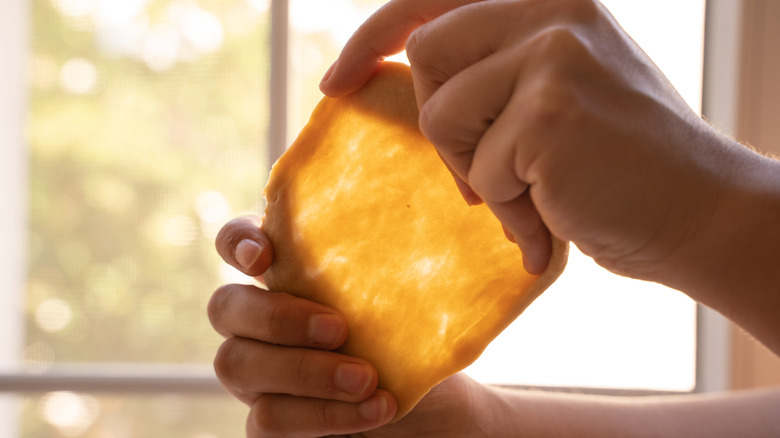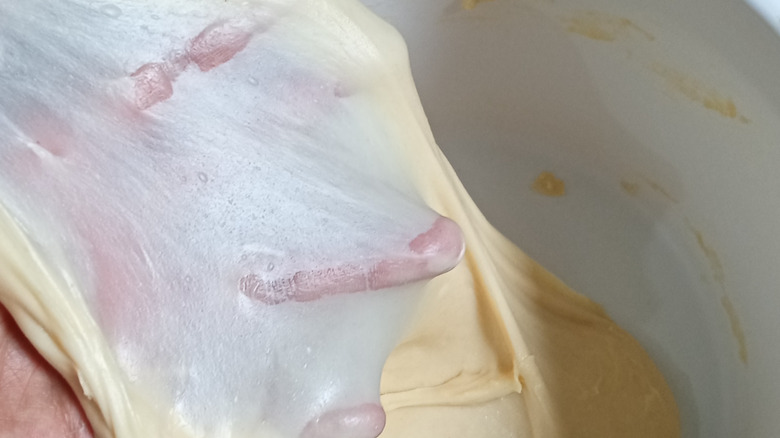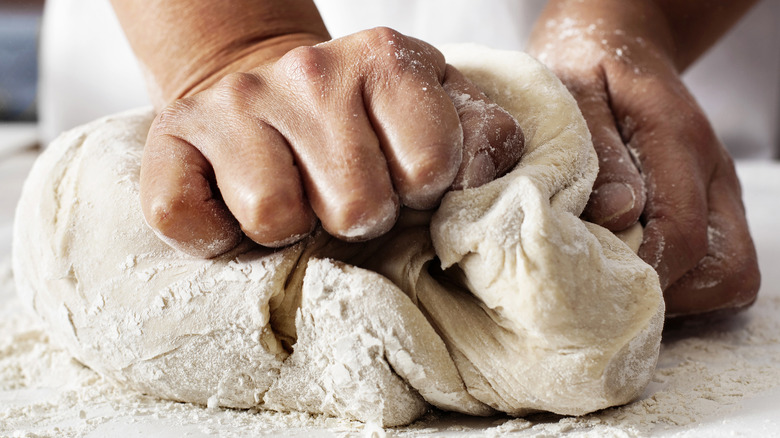What It Means To 'Pull A Window' When Baking Bread
Making bread really comes down to one thing: gluten development. You mix flour with water and knead the bread dough to denature and restructure protein strands into gluten so that when the yeast degasses, the dough can catch it, stretch, and expand. If you don't work the dough enough, the gluten won't be strong enough to raise the bread to its full potential. When you've worked with enough dough, you get a feel for this; you know by touch and by sight when bread dough has been kneaded enough. But there's also a failsafe way to test it so you're not left wondering. It's called pulling a window.
Windows — definitively see-through structures — are a weird way to talk about bread dough — an obviously opaque food — until you see it in action. If the gluten in the dough is properly developed, you will be able to stretch it so thin it becomes transparent. You'll be able to see light through it, like a window. You may even be able to read through it if you lay it over some lettering, like a stick of butter or a cookbook.
The windowpane test is a simple way to determine whether or not the gluten is developed enough in your dough. If it's not ready, the dough will tear as you stretch it thin. If that happens, you'll need to keep kneading until you get a successful window.
Tips for conducting a windowpane test
If you've kneaded bread dough, you may have experienced it becoming really tight and bouncy. If you pull or poke it, it will immediately snap back. This is why you need to rest your dough for a few minutes before you try to pull a window. If you don't, no matter how much you knead it, the gluten will never be stretchy and relaxed enough to achieve a window. You could knead until the cows come home, but unless you give the dough a little power nap, it will tear every single time.
When you think you have kneaded enough and you're ready to try a windowpane test, grab a little ping pong ball-sized piece of dough and flatten it out into a rough square. Let it rest for a few minutes, then pick it up and start gently pulling the edges of the dough thin, working from the center outward with your fingers. If the dough is ready, you can pull it to being paper-like and transparent before it tears. If the gluten has not developed enough, it will tear before this thinness is achieved. That's a sign that your dough needs more kneading.
Should you always pull a window when making bread?
The windowpane test is useful in many instances, but it's more helpful at certain times than others. In short, it's only necessary if you don't intend to rest your dough for very long — perhaps only for around an hour — after kneading.
If, however, your dough will go through a very long bulk fermentation phase, like an overnight dough or some stretch-and-folds over many hours, pulling a window before that phase won't be necessary. The reason no-knead bread recipes exist is that over enough time, gluten forms on its own in a well-hydrated dough. The mechanical process of kneading speeds it up, but time can also do what hands or dough hooks do. A batch of dough that fails the windowpane test may come out of the fridge eight to 12 hours later with strong gluten strands capable of pulling a beautiful window — we're all a lot more resilient after a proper rest, even bread dough.
Whole grain or seeded doughs can also make pulling a window particularly hard because the particles in the dough can be sharp enough to foil your efforts. What might look like a torn window due to underdeveloped gluten can actually be a tear caused by a sharp bit of bran or a seed ripping the dough.


